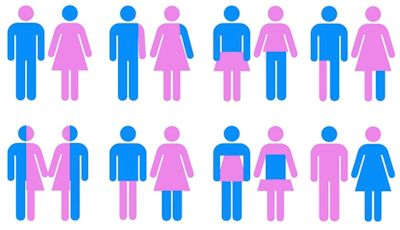Part 4 in a series of reflections.

Feminism made the first strides in separating out gender and sex as different ideas. When we compare different cultures or even the same culture over a period of time, it is easy to see that the ideals for behavior and gender expectations change in various contexts.
The way a person carries him- or herself, whether it is appropriate to touch others of the same or opposite gender in the course of a conversation, whether one looks another in the eye or looks away–these behaviors are sometimes regulated by gender expectations and vary from culture to culture. A behavior that is considered masculine or feminine in one culture may not map in the same way to another culture.
In this section we'll review two contributions by theorist Judith Butler to the ongoing discussion of gender, sexualities, and biological sex.
Performativity
Butler claims that all genders are performative. We learn as members of particular cultures what it means to act like a man or to act like a woman. However, our lives consist of performances that either pass or fail in light of established norms (which tend to shift over time). There is no such thing as the quintessential male or female, only performances that attempt to emulate previous performances.
Butler points to drag performances as an area where we see performativity at work both as emulation, but also with the opportunity of subversion of existing paradigms. Drag queens (and kings) either succeed or fail in their emulation of a particular gender through performing in certain ways that are deemed either feminine or masculine respectively by their audiences.
However, the best drag performers are not simply trying to be women or men. RuPaul illustrates this point well in a well-known quote:
I do not impersonate females! How many women do you know who wear seven-inch heels, four-foot wigs, and skintight dresses?
 A drag queen must be intelligible as a woman, but at the same time often has marked differences from women that we meet on the street every day. In the same way, drag king performances provide us with a mirror of what it means to be masculine.
A drag queen must be intelligible as a woman, but at the same time often has marked differences from women that we meet on the street every day. In the same way, drag king performances provide us with a mirror of what it means to be masculine.
With few exceptions, drag kings are not hard-bodied and muscled like macho images of manhood portrayed in the movies. Rather, drag kings portray masculinity primarily in attitude, manner of dress, and flirtation with female subjects in a way that "passes" as male behavior.At the same time, the presence of painted on facial hair and different body shapes point to realities outside of the standards of biologically normative males.
Both drag kings and drag queens, when viewed with a critical eye, show us the blurred edges around what it means to be a man or a woman.
Language and Legibility
We may agree that gender norms are culturally dictated. After reading the previous entries in this series, one might even come to the point of seeing how categories like gay and straight are culturally constructed. But let's go a step further.
Butler proposes that even our ideas around biological sex are as conditioned by cultural discourses as our concepts of gender. In her early works, Butler adds two new ideas to the conversation around gender identities and sex.
To illustrate this fact, just think for a moment about your immediate reaction to the claim that biological sex is a constructed category. Most people, on hearing this idea for the first time will point out that men have penises and women have vaginas, and nothing could be simpler than that.
The very fact that our attention focuses on the external genitalia of a newborn infant (or even earlier in ultrasounds) should serve as an indicator of just how embedded in our frameworks the idea of biological sex is.
Indeed, the very words penis, vagina, breasts, etc. have the effect of marking off legible zones of bodily erotic pleasure and obscuring other body parts. They also have a tendency to carve up bodies as a part of discourses of gender, sexuality, and biological sex.
Other zones such as the nape of the neck, the ear lobe, the hands, or even anuses—all of which are shared by both men and women—can just as easily be zones of pleasure. However, we do not tend to build social categories for people who experience pleasure through stimulation of these other body parts. Likewise, we we don't have cultural expectations built on whether or not a person has a particular hair or eye color.
A knee-jerk response may be that we divide people into men and women because it takes one of each to reproduce. However, this is also worth further examination.
Prepubescent children of both sexes are incapable of reproducing, as are women past a certain age. Even in sexual maturity, many men and women are not capable of becoming biological parents or may do so only with great difficulty and medical intervention. Yet the constructs of biological sex are applied to everyone regardless of their ability to reproduce.
Indeed, human cultures tend to place much more than the hope of continuing the species on exactly what genitals a child possesses.
Intersex
Another limit case in the discourse of biological sex is intersexed conditions. Here, a child born with ambiguous genitalia cannot be readily classified as either male or female.
Such children may have both a penis and a vagina, or may have gonadal tissues of that would differentiate into both testes and ovaries. In some cases, the penis may be considered too small to count on a normative scale. In some cases, there is a lack of gonadal structures assigned to either sex. There may also be chromosomal configurations that belie the common configurations of XX (female) and XY (male).
Sexual ambiguities occur in about 1 in every 500 children. However, beyond obstetricians and midwives, knowledge of this frequency is rather limited.
Further, with the rise of plastic surgery and the penchant for statistical norms, medical practice until very recently has been to "normalize" babies that are born with ambiguous genitalia. Surgeons intervene in the birth state to create genitals that are either expressly male or (more frequently) female.
However, there is some movement away from this trend, with Australia passing legislation allowing babies born with ambiguous genitalia to be designated as "X" rather than "M" or "F" on their birth certificates, while Germany has just followed suit this past weekend with the same procedure.
[Concluding thoughts]




